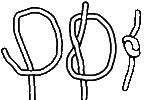![]()
Standard copyrights and disclaimer. Stoppers (
|
![]()
Knots on the end of a rope or yarn. There are a lot of situations where you need a knot
like this. Every application has its own special demands for knot properties. So you have
to choose carefully. You can use a stopper to prevent a rope or yarn from unfolding, but
please do that only in cheap rope/yarn. Use a proper whipping in all other cases.
The Overhand Knot or Half Knot

This is the simplest knot. Therefore probably the most used. The knot is very useful to
support knots in yarns. The loose ends become a bit thicker. When this support makes the
total bend too bulky you have to look for another bend. The overhand knot is not strong,
so it is not used in situations where you might expect great force. It also reduces the
strength of the rope or yarn by about 50%. But as an "anti-slip-knot" it does
not have to withstand a lot.
This knot on the
WEB.


The double overhand knot is beautiful, thicker than the common overhand knot, but not
any stronger. But use it with caution. The double overhand knot is also called the
bloodknot when it is used at the end of a whip. This knot has several ways of tying and in
principle two ways of working up. Both ways of tying shown here also show both results.
The bloodknot shown in the middle is the preferred way of working up the second way of
tying marked with the crosses. The bloodknot is very hard to untie after it has been under
stress. If you put an object through the cross-marked hole the knot will work up as the strangleknot. It is usefull to practice this way.
This knot on the
WEB.

If you make more than two turns in the overhand knot it wil be fatter. (But hardly
stronger.) In twined rope it is important to work up the knot very carefully. (It will not
only look neater, it wil prevent 'kinking' which will weaken the rope even more!)
This knot on the
WEB.

This knot is larger, stronger and more easy to untie than the overhand
knot. It does not harm your rope as much as the overhand knot does. So therefore sailors
use this knot in most cases. (! not for bend support, where the smaller overhand is used,
or in rope, a permanent small stopper)
This knot on the
WEB.
![]()
Because this is an non-comercial site I can and will not allow junk mail nor spam. Therefore comercial, non-personal and bulkmail will be charged with handling costs of $100 per mail.
![]()